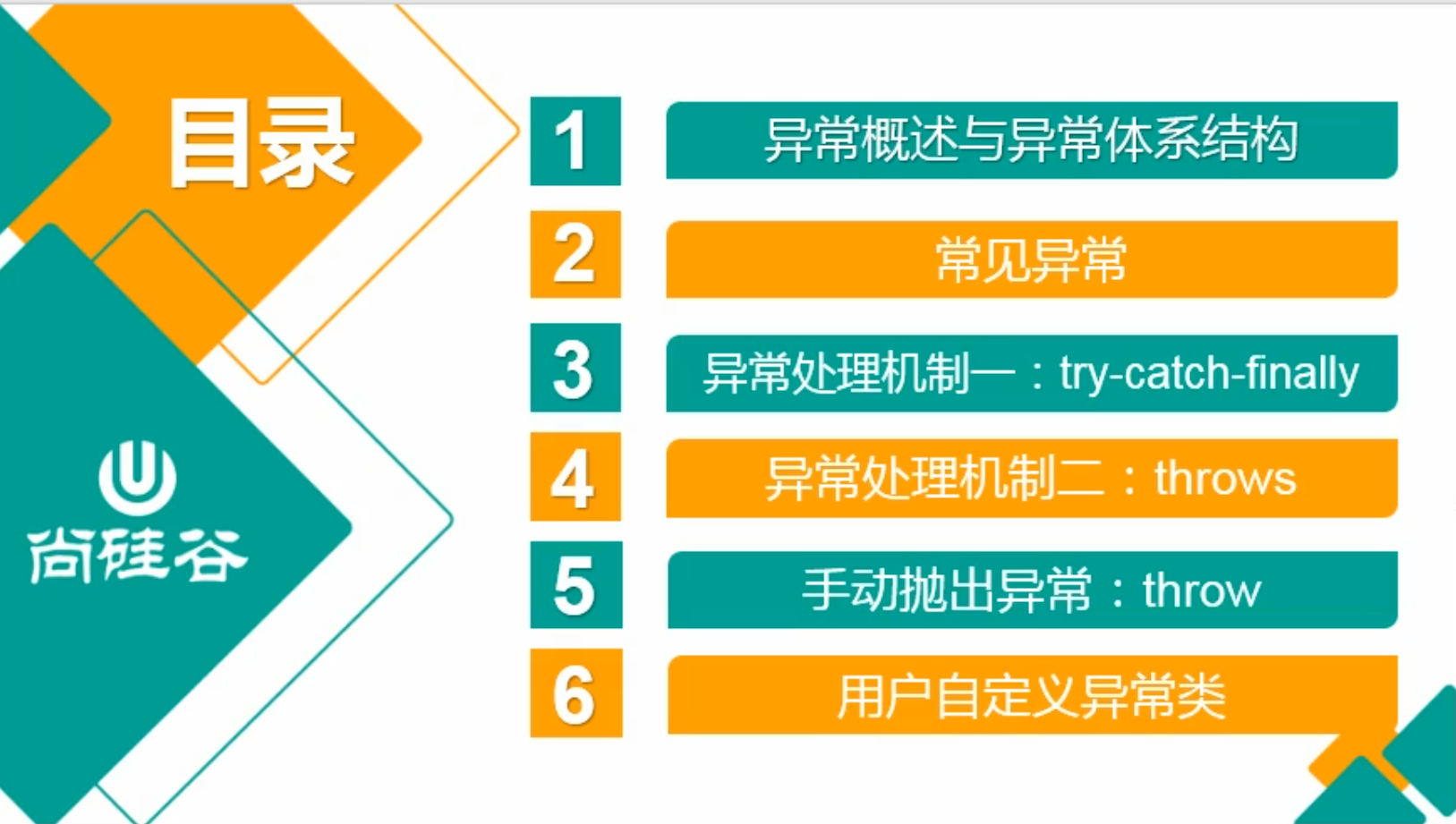
7 - 1 异常概述与异常体系结构
7 - 2 常见异常

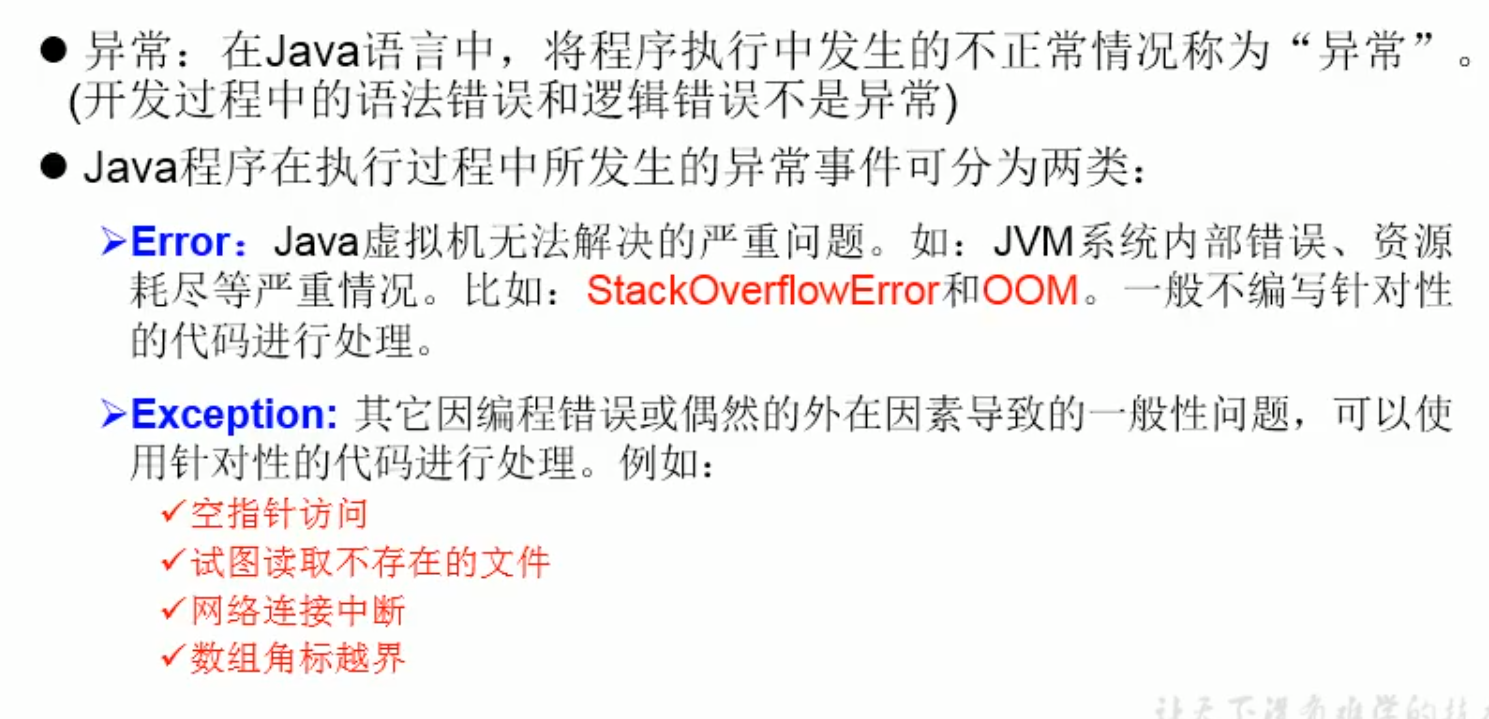
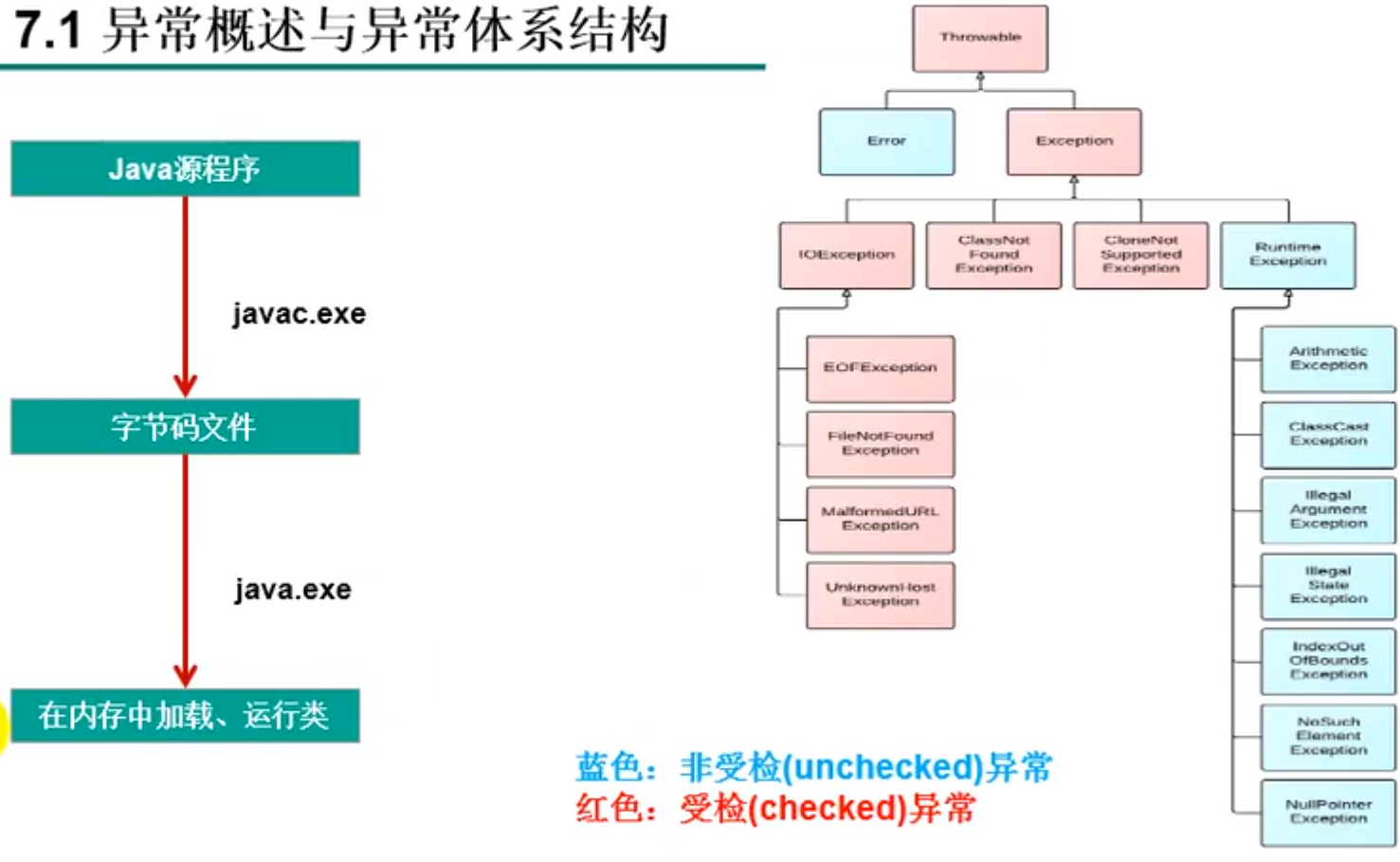
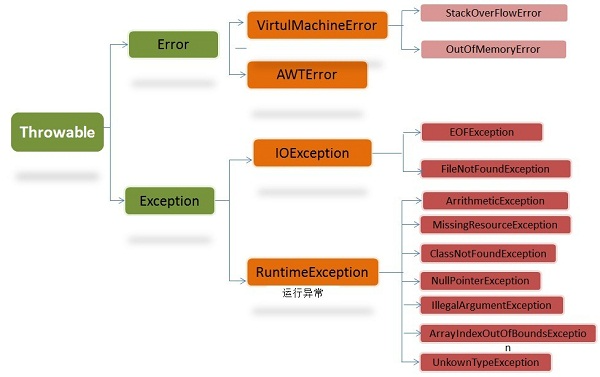
一、Error
一般不编写针对性代码进行处理
package com.atguigu.java;
public class ErrorTest {
public static void main(String[] args) {
//1.栈溢出:java.lang.StackOverflowError
// main(args);
//2.堆溢出:java.lang.OutOfMemoryError(OOM)
// Integer[] arr = new Integer[1024*1024*1024];
}
}
二、Exception
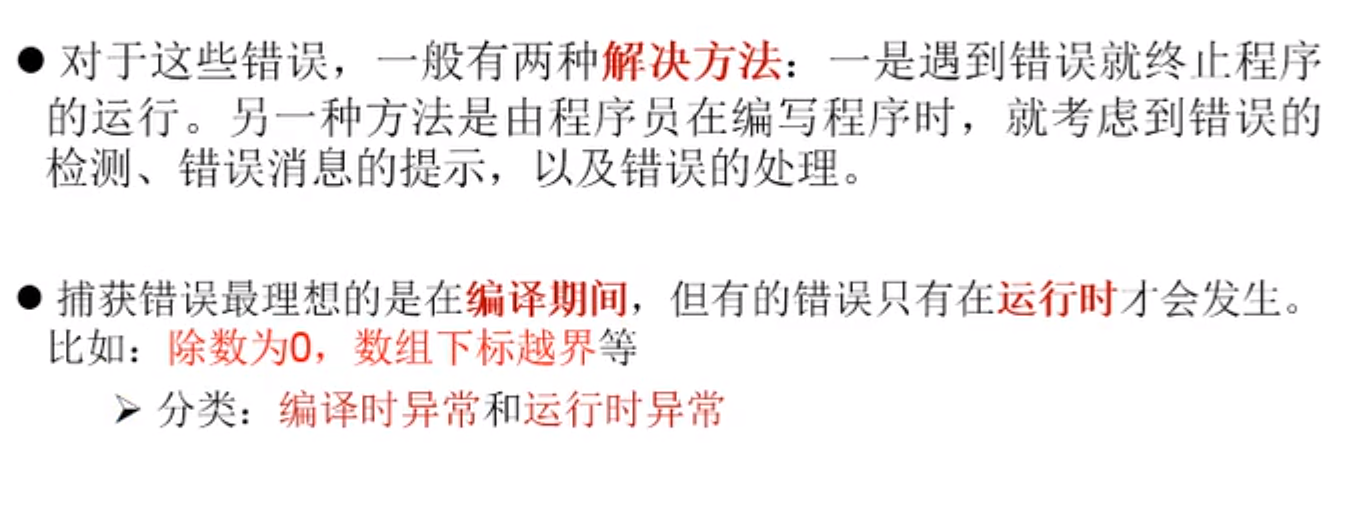
1.分类:
编译时异常:
例子:
IOException
FileNotFoundException
ClassNotFoundException
运行时异常:
例子:
NullPointException
ArrayIndexOutOfBoundsException
ClassCastException
NumberFormatException
InputMismatchException
面试题:常见的异常有哪些,举例说明:
package com.atguigu.java;
import java.io.File;
import java.io.FileInputStream;
import java.util.Date;
import java.util.Scanner;
import org.junit.Test;
public class ExceptionTest {
//******************编译时异常********************
@Test
/* public void test7(){
File file = new File("hello.txt");
FileInputStream fis = new FileInputStream(file);
int data = fis.read();
while(data != -1)
{
System.out.println((char)data);
data = fis.read();
}
fis.close();
}*/
//******************运行时异常********************
public void test6(){
int a = 10;
int b = 0;
System.out.println(a / b);
}
//InputMisMatchException
@Test
public void test5(){
Scanner scan = new Scanner(System.in);
int score = scan.nextInt();
System.out.println(score);
}
//NumberFormatException
@Test
public void test4(){
String str = "123";
str = "abc";
int num = Integer.parseInt(str);
}
//ClassCastException
@Test
public void test3(){
Object obj = new Date();
String str = (String)obj;
}
//ArrayIndexOutOfBoundsException
@Test
public void test2(){
/* int[] arr = new int[4];
System.out.println(4);*/
String str = "abc";
System.out.println(str.charAt(3));
}
//NullPointerException
@Test
public void test1(){
/* int[] arr = null;
System.out.println(arr[3]);*/
/* String str = "abc";
str = null;
System.out.println(str.charAt(0));*/
}
}
7 - 3 异常处理机制一:try-catch-finally

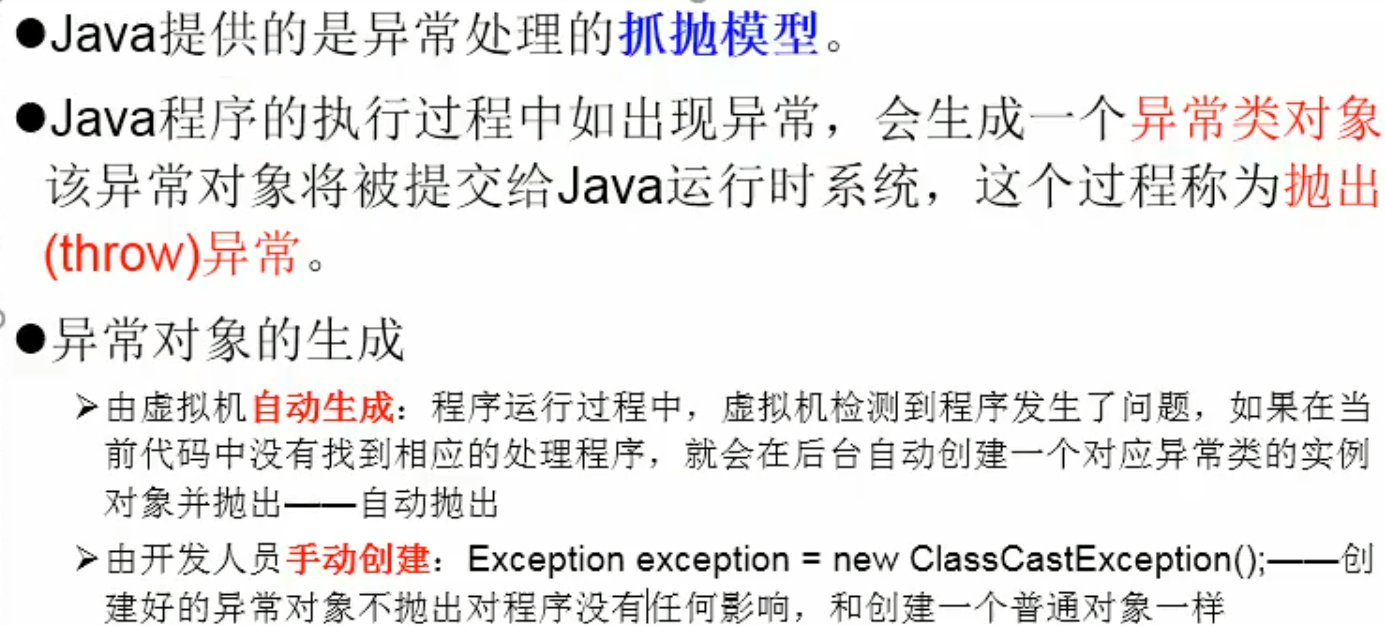
异常的处理:抓抛模型
过程一:
“抛”,程序在正常执行过程中,一旦出现异常,就会在异常代码处生成一个对应异常类的对象,并将此对象抛出。
一旦抛出对象以后,其后的代码就不再执行。
过程二:
“抓”:可以理解为异常的处理方式:① try - catch -finally ② throws
二、try-catch-finally的使用
try{
//可能出现异常的代码
}catch(异常类型1 变量名1){
//处理异常的方式一
}catch(异常类型2 变量名2){
//处理异常的方式二
}...
finally{
//一定会执行的代码
}
1.说明:
1.finally是可选的。
2.使用try将可能出现异常代码包装起来,在执行过程中,一旦出现异常,就会生成一个对应异常类的对象,根据此对象的类型,去catch中去匹配
3.一旦try中的异常对象匹配到某一个catch时,就进入catch中进行异常的处理。一旦处理完成,就跳出try-catch结构(在没有写finally的情况下)。继续执行其后的代码
4.catch中的异常类型如果没有子父类关系,则谁声明在上,谁声明在下无所谓
catch中的异常类型如果满足子父类关系,则要求子类一定声明在父类的上面,否则报错
5.常用的异常处理的方式:①String getMessage() ②printStackTrace
6.在try结构中出现的结构,出了try结构中,就不能再被调用
7.try-catch-finally结构可以嵌套
体会1:使用try - catch - finally处理编译时异常,使得程序在编译时就不再报错,但是运行时仍可能报错。相当于我们使用try - catch - finally将一个编译时可能出现的异常,延迟到运行时出现。
体会2:开发中,由于运行时异常比较常见,所以我们通常就不针对运行时异常编写try-catch-finally了。
针对于编译时异常,我们一定要处理。
2.finally的使用:
1.finally是可选的
2.finally中声明的是一定会被执行的代码。即使catch中又出现异常了,try中又return语句,catch中有return语句等情况。
3.像数据库连接、输入输出流,网络编程Socket等资源,JVM是不能自动的回收的,我们需要自己手动进行资源的释放,此时的资源释放,就需要声明在finally中。
7 - 4 异常处理机制二throws
1.说明:
"throws + 异常类型"写在方法的声明处。指明此方法执行时,可能会抛出的异常类型。一旦当方法体执行时,出现异常,仍会在异常代码处生成一个异常类的对象,此对象满足throws后异常类型时,就会被抛出。异常代码后续的代码就不会继续执行
2.体会:
try-catch-finally:真正的吧异常给处理掉了
throws的方式知识将异常抛给了方法的调用者,并没有真正将异常处理掉。
3.重写方法异常抛出的规则
1.子类重写的方法抛出的异常类型不大于父类被重写的方法抛出的异常类型
4.开发中如何选择使用try-catch-finally还是throws?
1.如果父类中被重写的方法没有throws方式处理异常,则子类重写的方法也不能使用throws,意味着如果子类重写的方法中有异常,必须使用try-catch-finally
2.执行的方法中,先后又调用了另外的几个方法,这几个方法是递进关系执行的。我们建议这几个方法使用throws的方式进行处理。而执行的方法a可以考虑用try-catch-finally处理
7 - 5 手动抛出异常
关于异常对象的产生:
① 系统自动生成的异常对象
② 手动生成的一个异常对象,并抛出(throw)
package com.atguigu.java2;
public class StudentTest {
public static void main(String[] args) {
try{
Student s = new Student();
s.regist(-1001);
System.out.println(s);
}catch(Exception e){
System.out.println(e.getMessage());
}
}
}
class Student{
int id;
public void regist(int id) throws Exception{
if(id > 0){
this.id = id;
}else{
// System.out.println("您输入的数据非法!");
//手动抛出异常对象
throw new RuntimeException("您输入的数据非法!!!");
}
}
}
7 - 6 用户自定义异常类
如何自定义异常类?
1.继承于现有的异常结构:RuntimeException Exception
2.提供全局常量:serialVersionUID
3.提供重载的构造器
package com.atguigu.java2;
public class MyException extends Exception{
static final long serialVersionUID = -3387516993124229948L;
public MyException(){
}
public MyException(String msg){
super(msg);
}
}
package com.atguigu.java2;
public class StudentTest {
public static void main(String[] args) {
try{
Student s = new Student();
s.regist(-1001);
System.out.println(s);
}catch(Exception e){
System.out.println(e.getMessage());
}
}
}
class Student{
int id;
public void regist(int id) throws MyException{
if(id > 0){
this.id = id;
}else{
// System.out.println("您输入的数据非法!");
//手动抛出异常对象
throw new MyException("不能输入负数!!!");
}
}
}
练习:
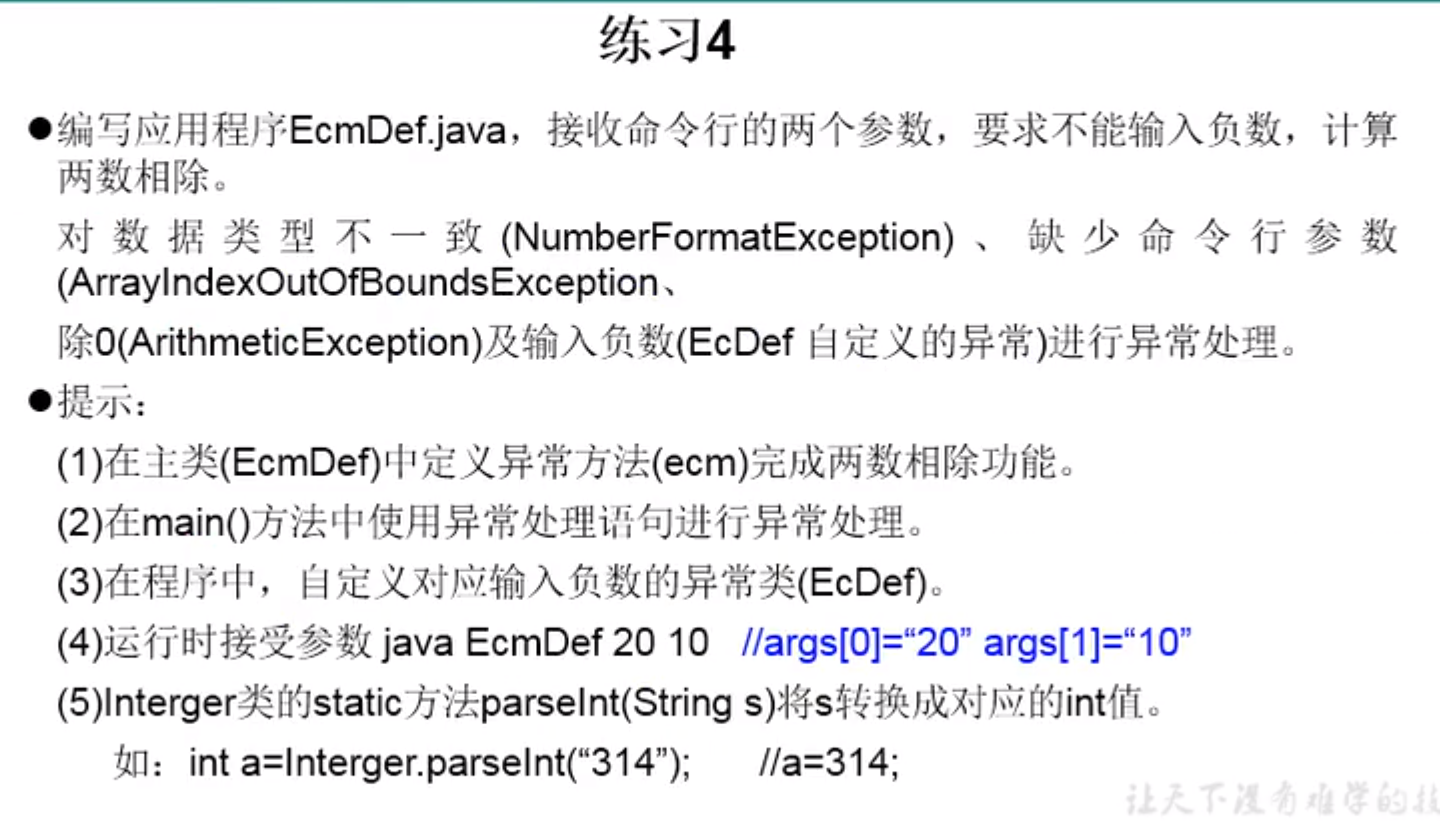
public class EcDef extends Exception{
static final long serialVersionUID = -3387516993948L;
public EcDef(){
}
public EcDef(String msg){
super(msg);
}
}
public class EcmDef {
public static void main(String[] args) {
try{
int i = Integer.parseInt(args[0]);
int j = Integer.parseInt(args[1]);
int result = ecm(i,j);
System.out.println(result);
}catch(NumberFormatException e){
System.out.println("数据类型不一致!");
}catch(ArrayIndexOutOfBoundsException e){
System.out.println("缺少命令行参数!");
}catch(ArithmeticException e){
System.out.println("除0,算术异常!");
}catch(EcDef e){
System.out.println(e.getMessage());
}
}
public static int ecm(int i, int j) throws EcDef{
if(i < 0 || j < 0){
throw new EcDef("分子或分母为负数了!");
}
return i / j;
}
}





















 997
997











 被折叠的 条评论
为什么被折叠?
被折叠的 条评论
为什么被折叠?








